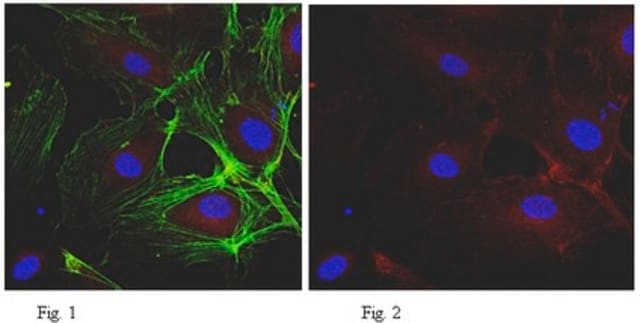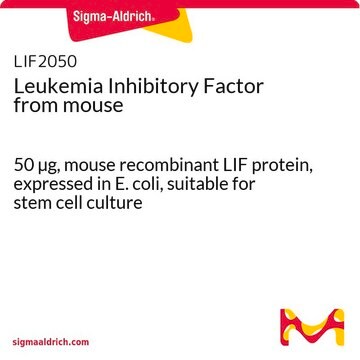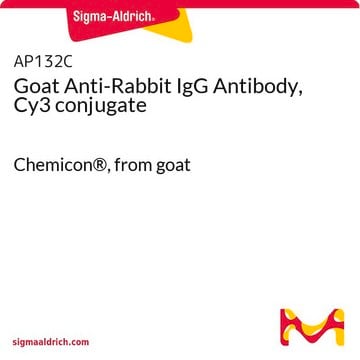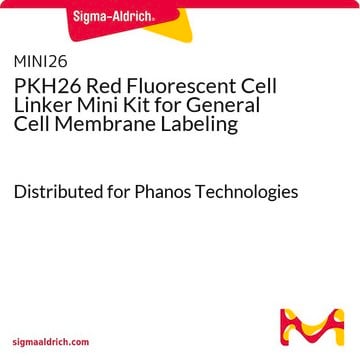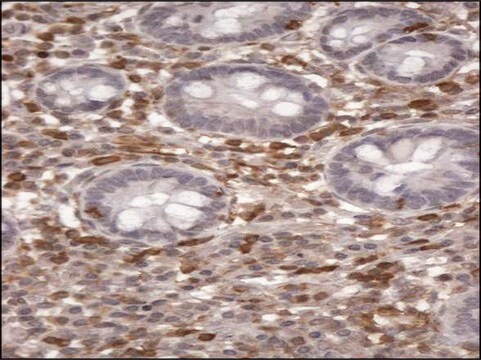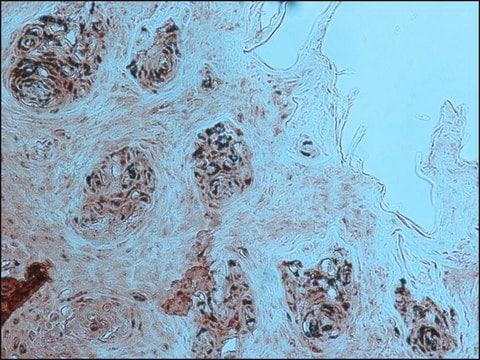MABT886
Anti-VE-Cadherin Antibody, clone Vli37
culture supernatant, clone Vli37, from rabbit
Sinônimo(s):
Cadherin-5, CD144, Vascular endothelial cadherin, VE-Cad, VE-cadherin, VEcad
About This Item
Produtos recomendados
fonte biológica
rabbit
Nível de qualidade
forma do anticorpo
culture supernatant
tipo de produto de anticorpo
primary antibodies
clone
Vli37, monoclonal
reatividade de espécies
bovine, mouse
reatividade da espécie (prevista por homologia)
rat (based on 100% sequence homology)
técnica(s)
immunocytochemistry: suitable
immunohistochemistry: suitable (paraffin)
western blot: suitable
Isotipo
IgG
nº de adesão NCBI
nº de adesão UniProt
Condições de expedição
dry ice
modificação pós-traducional do alvo
unmodified
Informações sobre genes
mouse ... Cdh5(12562)
Descrição geral
Especificidade
Imunogênio
Aplicação
Cell Structure
Adhesion (CAMs)
Western Blotting Analysis: An 1:2,000 dilution from a representative lot detected VE-cadherin expression in lysastes from mouse lung tissue, mouse brain endothelial bEnd.3 cells, and bovine aortic endothelial GM7372 cells (Courtesy of Dr. Volkhard Lindner, Maine Medical Center Research Institute, Scarborough, ME).
Immunohistochemistry Analysis: An 1:250-5,000 dilution from a representative lot detected VE-cadherin immunoreactivity in formalin-fixed, paraffin-embeded mouse lung, aorta, and liver tissue sections (Courtesy of Dr. Volkhard Lindner, Maine Medical Center Research Institute, Scarborough, ME).
Immunocytochemistry Analysis: An 1:500-5,000 dilution from a representative lot detected VE-cadherin immunoreactivity in bovine aortic endothelial GM7372 cells (Courtesy of Dr. Volkhard Lindner, Maine Medical Center Research Institute, Scarborough, ME).
Qualidade
Western Blotting Analysis: An 1:500 dilution of this antibody detected VE-Cadherin in 10 µg of mouse lung tissue lysate.
Descrição-alvo
forma física
Armazenamento e estabilidade
Handling Recommendations: Upon receipt and prior to removing the cap, centrifuge the vial and gently mix the solution. Aliquot into microcentrifuge tubes and store at -20°C. Avoid repeated freeze/thaw cycles, which may damage IgG and affect product performance.
Outras notas
Exoneração de responsabilidade
Not finding the right product?
Try our Ferramenta de seleção de produtos.
Código de classe de armazenamento
10 - Combustible liquids
Classe de risco de água (WGK)
WGK 2
Certificados de análise (COA)
Busque Certificados de análise (COA) digitando o Número do Lote do produto. Os números de lote e remessa podem ser encontrados no rótulo de um produto após a palavra “Lot” ou “Batch”.
Já possui este produto?
Encontre a documentação dos produtos que você adquiriu recentemente na biblioteca de documentos.
Nossa equipe de cientistas tem experiência em todas as áreas de pesquisa, incluindo Life Sciences, ciência de materiais, síntese química, cromatografia, química analítica e muitas outras.
Entre em contato com a assistência técnica